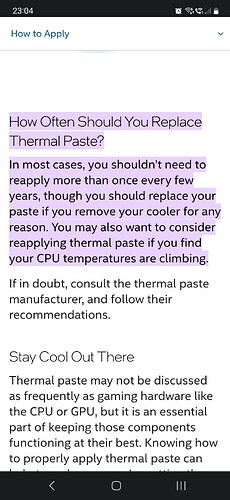I’m using three NUC:s right now, one is client (W10), one is bridge (ROCK), and one is the core (ROCK).
I’ve mounted the client and bridge NUC:s in Akasa fanless cases because they are in the kitchen and living room, and I still have one more case that I don’t use right now.
Would I benefit somehow from mounting also the core NUC in a fanless case? It’s in the basement, so the fans doesn’t matter. But would sound quality differ?
No it wouldn’t.
If the case provides sufficient cooling for a Core (possibly under load with DSP), you could forget about having to clean the fans once in a while
No you wouldn’t. Especially, if it is out of the listening room.
While everyone should clean any computer’s fans every so often, that doesn’t mean that a fanless case is completely without maintenance. Dust accumulates and needs to be blown out, thermal paste needs to be checked, cleaned and re-applied every so often.
A fanless case needs to be given/placed in good airflow. I’ve dealt with many users who have plopped a fanless case ontop of an amp and wondered why it overheated and died. Same with putting it in an enclosed space.
First time i have heard of ‘thermal paste maintenance’… I mean is that really a thing?
Yep, thermal paste maintenance is required.
I see too many failed PCB boards on fan control units on AC equipment because thermal paste hadn’t been reapplied at regular/needed intervals.
Same for computers.
Once it gets to a certain condition it loses the heat transfer rate required.
Intel recommends every few years. I do it at least once every 2 years.
![]()
It’s a PC nerd OCD thing. There are raging debates on hardware forums on whether it is necessary, pointless, or harmful. In any case it is not a solution for fundamentally inadequate cooling, and there are a many misconceptions around about how thermal paste works and whether its drying is a bad thing that requires repasting. IF you separate the CPU from the heatsink, you have to repaste.
And if you do it, you have to do it properly, with ESD prevention.
I very much disagree ![]()
Link?
Anyway, in PC nerd forums it’s the same as in audiophile forums. Google “repasting necessary” and form your own conclusions
“You shouldn’t need to reapply more than once every few years” it NOT the same as “you should do it every few years”. Language!
Yeah, CPU changes need, nae demand a reapplication. There after, unless you are having cooling issues, I would thought its advisable to leave well alone.
Building a fanless system - due diligence in thermal paste application is a must.
You didn’t, true. You wrote that “it’s required” and “Intel recommends”. Let me correct myself: “In most cases, you shouldn’t need to reapply more than once every few years” is NOT the same as “thermal paste maintenance is required” and “Intel recommends every few years”
If it is done, it may well reduce CPU temp by a few degrees, but if you rely on that, the cooling solution was inadequate to begin with. And if it is not done very, very well, it may well make things worth.
But which brand of thermal paste ‘sounds’ the best? I think we need to know. ![]()
It does not matter which one, as long as it is 3 times as expensive as the others. ![]()
This is a good article for reference
I’ve used both Arctic and ProlimaTech PK-3 Nano Aluminum and haven’t had a complaint about either. Don’t forget to clean all the surfaces of previous thermal paste residue before applying a new application.
There is no ranking for sound in this article. Disappointed!
Well, for those who have never really used thermal paste, some are definitely easier to work with than others in terms of application and clean up. The Thermal Conductivity rating is also a nice reference especially if using in a fanless environment.
Just joking because you replied to “But which brand of thermal paste ‘sounds’ the best?”
I opted for a fanless case. The fans generate physical/mechanical noise, but there is also a chance the added electrical noise from the motors, controllers etc will affect the signal. Same goes for switching power supply’s over linear. If you can do it with less it will probably sound better.
To get really into it, see the lengths that Taiko Extreme go to, in reducing noise floor to the absolute minimum. There is a really good deep dive article on Computer Audiophile on it.
If you have the case, I would try it, but if you are going to spend money, a LPS would probably give ‘better’ performance.
A digital signal over the network? How? If it can, why do the fans in my bank’s data center not affect my account balance?
Perhaps the fan adds an Audible Around (ing) error ![]()
Not a debate i would join in with
